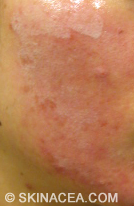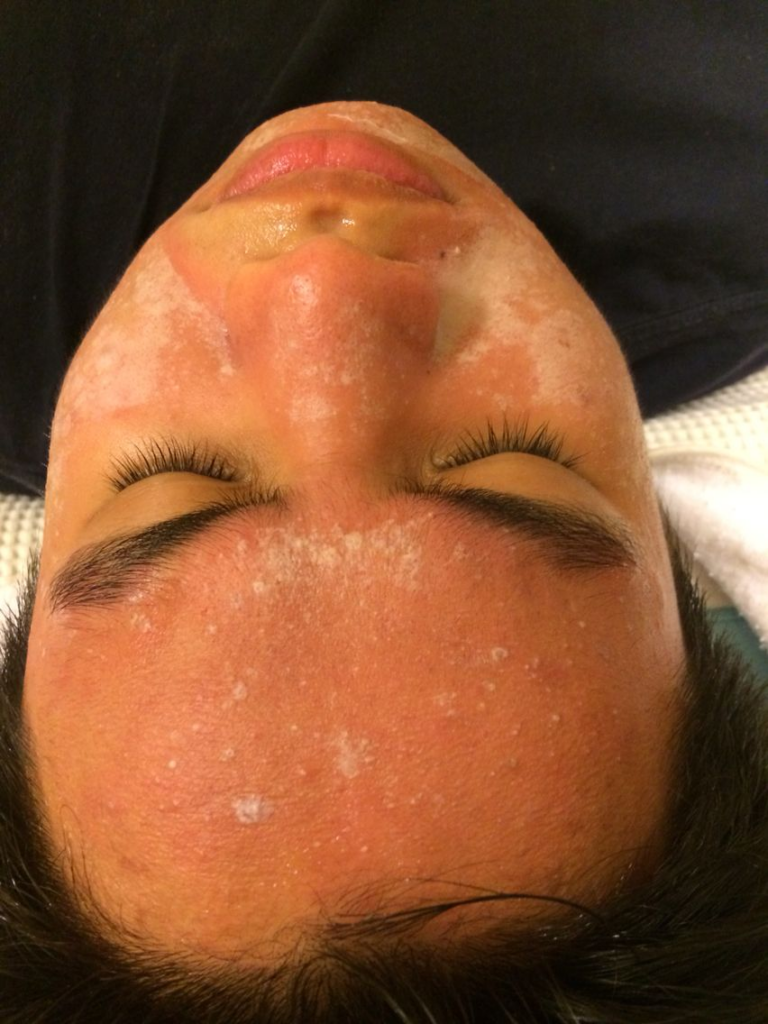
Chemical peels are cosmetic treatments that can be applied to the face, hands, and neck. They’re used to improve the appearance or feel of the skin. During this procedure, chemical solutions will be applied to the area being treated, which causes the skin to exfoliate and eventually peel off. Once this happens, the new skin underneath is often smoother, appears less wrinkled, and may have less damage.
There are a number of reasons people may get chemical peels. They may be trying to treat a variety of things, including:
- wrinkles and fine lines
- sun damage
- acne scars
- hyperpigmentation
- scars
- melasma
- uneven skin tone or redness

Frosting is when parts of your skin turn white during a chemical peel. It happens when the surface of your skin is exfoliated away by the acidic solution.
Frosting generally doesn’t occur during glycolic acid or lactic acid peels, but during deeper peels, such as TCA peels. Even then, frosting usually only happens when you get strong TCA peels (15% or higher) or layered peels.
However, whether your skin will frost will depend on your skin itself and what products you have been using. For instance, if you have never gotten a chemical peel before and have been using retinoids, your skin may actually frost during a medium-depth peel. Any places where you have skin injuries, such as scabs or picked pimples, will also frost more easily.
Frosting looks like something flat and frothy that you can’t physically scrape off your skin. It’s a bit hard to imagine, so here’s a picture of frosting (and my very red skin) during a one layer 15% TCA peel:
Frosting from a chemical peel
Frosting may look really scary, but it is normal for medium depth chemical peels. Places where your skin frosts will actually be the places where you will peel (and brown) the most. This doesn’t mean that you want to frost everywhere though. Places on your skin that frost usually scab over and take longer to heal than places on your skin that don’t frost.
When frosting occurs, the chemical peel is usually neutralized immediately (with water or a prepared neutralizing solution) so it doesn’t damage your skin any further. Letting your skin frost too much is bad, but some frosting is generally okay, as long as you take good care of your skin post-peel.
How Long Does Frosting Last After Chemical Peel
In a recent statement, Dr. Emer emphasized the importance of proper post op skin care following a cosmetic procedure. While expressing the need for caution, he acknowledged that the presence of frosting immediately after the procedure is not uncommon. However, he suggested that the frosting should dissipate within the next 30 minutes, accompanied by redness.
Dr. Emer’s advice is grounded in medical expertise and experience, although he acknowledged that stating “100% maybe too strong.” This acknowledgment highlights the nuanced nature of post op skin care and the variability in individual healing processes. Nevertheless, Dr. Emer remains confident that with the right aftercare, skin should heal within 5-6 days.
Proper post op care is essential in supporting the healing process and ensuring optimal outcomes. This includes following the instructions provided by the healthcare provider, keeping the treated area clean and moisturized, and avoiding excessive sun exposure. Patients should also be vigilant for any signs of infection, such as increasing redness, swelling, or pus, and seek medical attention if necessary.Overall, Dr. Emer’s emphasis on post op skin care serves as a reminder of the importance of taking care of the skin following cosmetic procedures. By following his advice and practicing diligent aftercare, patients can support the healing process and achieve the desired results.
What type of chemical peels can I get?
There are three different types of chemical peels that you can get. These include:
- Superficial peels, which use mild acids like alpha-hydroxy acid to gently exfoliate. It only penetrates the outermost layer of skin.
- Medium peels, which use trichloroacetic or glycolic acid to reach the middle and outer layer of skills. This makes it more effective for removing damaged skin cells.
- Deep peels, which fully penetrate the middle layer of the skin to remove damaged skin cells; these peels often use phenol or tricholoracetic acid.
How much do chemical peels cost?
Chemical peels are almost always considered a cosmetic procedure, and insurance rarely covers it. You’ll be paying for the procedure out of pocket. Your initial consultation visit, however, may be covered by insurance.
The cost of the procedure will vary depending on factors like location, expertise of the provider, and what type of peel you want to get. Light peels can cost as low as $150, and deep peels can cost $3,000 or more (specifically if it requires anesthesia, or in-patient stays). According to the American Society of Plastic Surgeons, the current average cost of a chemical peel is $673.
How is a chemical peel done?
Chemical peels are typically done in-office; deep peels may be done in an outpatient surgical facility. Before the procedure, they will likely have you tie back your hair. Your face will be cleaned, and eye protection like goggles or gauze may be applied.
Your doctor may numb the area with a topical anesthetic, especially if you’re receiving a deep peel. For deep peels, your doctor may also use a regional anesthetic, which will numb large areas. They are particularly likely to do this if you’re having your face and neck treated. For deep peels, you’ll also be given an IV, and your heart rate will be closely monitored.
Light peel
During a light peel a cotton ball, gauze, or brush will be used to apply a chemical solution like salicylic acid to the area being treated. The skin will start to whiten, and may have a slight stinging sensation. Once complete, the chemical solution will be removed or a neutralizing solution will be added.
Medium peel
During a medium chemical peel, your doctor will use a gauze, special sponge, or a cotton-tipped applicator to apply the chemical solution to your face. This may contain glycolic acid or trichloroacetic acid. A blue color may be added to the trichloroacetic acid, commonly known as a blue peel. The skin will begin to whiten, and your doctor will apply a cool compress to the skin. You may feel stinging or burning for up to 20 minutes. No neutralizing solution is needed, though they may give you a hand-held fan to cool your skin. If you’ve had the blue peel you will have a blue coloring of your skin that may last for several days after the peel.
Deep peel
During a deep chemical peel, you will be sedated. The doctor will use a cotton-tipped applicator to apply phenol to your skin. This will turn your skin white or gray. The procedure will be done in 15-minute portions, to limit the skin exposure to the acid.
Where do i go for a chemical peel?
Chemical peels are best performed by a board-certified dermatologist near you. Chemical peels are performed in-office as an outpatient procedure, meaning there is no overnight stay. Peels performed by a board-certified dermatologist ensure safety, training, and experience, but as always we recommend you ask questions and see the credentials of the person you are considering to perform the chemical peel.

What is frosting with a chemical peel
Frosting is when parts of your skin turn white during a chemical peel. It happens when the surface of your skin is exfoliated away by the acidic solution.
Frosting generally doesn’t occur during glycolic acid or lactic acid peels, but during deeper peels, such as TCA peels. Even then, frosting usually only happens when you get strong TCA peels (15% or higher) or layered peels.
However, whether your skin will frost will depend on your skin itself and what products you have been using. For instance, if you have never gotten a chemical peel before and have been using retinoids, your skin may actually frost during a medium-depth peel. Any places where you have skin injuries, such as scabs or picked pimples, will also frost more easily.
Frosting looks like something flat and frothy that you can’t physically scrape off your skin. It’s a bit hard to imagine, so here’s a picture of frosting (and my very red skin) during a one layer 15% TCA peel:
Frosting may look really scary, but it is normal for medium depth chemical peels. Places where your skin frosts will actually be the places where you will peel (and brown) the most. This doesn’t mean that you want to frost everywhere though. Places on your skin that frost usually scab over and take longer to heal than places on your skin that don’t frost.
When frosting occurs, the chemical peel is usually neutralized immediately (with water or a prepared neutralizing solution) so it doesn’t damage your skin any further. Letting your skin frost too much is bad, but some frosting is generally okay, as long as you take good care of your skin post-peel.
Chemical peel post care instructions

- The peeling may take anywhere from 7-10 days on average or longer depending on internal and external factors such as skin type, age, weather, lifestyle, and hormones. Slight redness and skin sensitivity and flaking can occur as your treatment eliminates dead surface skin cells. Each treatment may vary. Other areas of the body will react differently because your skin has a different texture on your face and scalp than on your chest, back, arms, and legs. The healing process may take longer in those areas.
- Your skin may take on a rough, patchy, darkened quality a few days after this treatment. This is normal and expected and it will resolve on its own. The first areas to peel are usually around the nose and mouth, but can begin anywhere. Most people begin peeling on the 3rd or 4th day after treatment. It is also possible to not peel at all. If this occurs, you will still benefit from the treatment because the skin has exfoliated microscopically.
- Possible side effects include but are not limited to: mild to extreme redness, temporary tightness, itching, swelling, and dryness of the skin similar to a sunburn or windburn. This will usually subside in 2-3 days. A prescription of hydrocortisone, or over-the-counter hydrocortisone (Vanicream HCⓇ) may be recommended if the skin is inflamed or irritated.
- You may GENTLY apply a cold compress to the treated area(s) as needed for any burning or irritation associated with your treatment.
- Make sure to avoid excessive heat on the treated area and direct sun exposure of any kind, as well as tanning beds and self-tanners to the treated areas for 4 weeks after treatment.
- Do NOT engage in strenuous exercise for 2-3 days after treatment because it may exacerbate the inflammatory and can cause your skin to become extremely inflamed.
- Sweating excessively after treatment can irritate the skin or cause blistering due to the sweat being unable to escape through the top layer of dead skin. Try to avoid sweating until after you have stopped peeling to avoid lifting the skin prematurely, as this can cause scarring.
- Do NOT use any acidic products such as retinoids or tretinoins, acne medication products such as Retin-AⓇ, TazoracⓇ, RenovaⓇ, AtralinⓇ, ZianaⓇ, VeltinⓇ, DifferinⓇ, the antibiotic Doxycycline, AHAs (lactic, glycolic, tartaric, etc.), BHAs (salicylic), benzoyl peroxide, vitamin C products, lightening agents such as hydroquinone or any exfoliative products including loofahs or coarse sponges to your skin for 2 weeks after your chemical peel, or more if you notice your skin becomes sensitive to application. These medications and products increase your photosensitivity, which can significantly increase the likelihood of complications.
- Do NOT tweeze, pick, rub, exfoliate, wax, use a depilatory, undergo electrolysis, or schedule a facial or cosmetic service such as laser resurfacing, or IPL on a treated area(s) for 4 weeks after your treatment. To reduce the risk of scarring, you do not want to remove the dry, rough, dead skin faster than your body wants to.
- Do NOT get your hair dyed until a week after you have finished peeling, if your treatment was performed on the face or neck. For most people, week 3 post-peel is the best time to have your hair color treated.
- This procedure can stimulate cold sores. If you have an outbreak after your treatment, please call the office to inquire about obtaining a prescription. Please ask to speak with the esthetician, Alli.
How to Care for your Skin Post-Peel
Cleanse Gently: Your skin may be fragile for 5-7 days. Cleanse your skin with COOL water (hot water will cause inflammation to the skin) using only your fingertips – no washcloths, loofahs, buff puffs, sponges, ClarisonicⓇ, etc. We recommend using the Revision Gentle Cleanser. Other mild cleansers such as Dove Unscented Bar Soap for Sensitive SkinⓇ, AveenoⓇ, CetaphilⓇ, CeraVeⓇ, or VanicreamⓇ may be recommended by your esthetician, depending on your specific needs.
Moisturize Often: Letting the skin dry out may cause discomfort. We recommend using SkinCeuticals Phyto Corrective GelⓇ and SkinCeuticals Epidermal RepairⓇ to help your skin recover. For strong peels, you may use petroleum jelly for the first few days or as needed on sensitive areas that are peeling. When you start to peel, use a non-comedogenic moisturizer such as AveenoⓇ, VanicreamⓇ, CetaphilⓇ, or CeraVeⓇ, until the skin feels back to normal. This will promote the healing process by locking in moisture and reducing the chance of a bacterial infection, redness, and irritation. Use these products several times per day or as needed. Topical hydrocortisone may be recommended, depending on your specific needs.
Protect Your Skin: Heat and sun exposure can cause inflammation to the skin. Remember to avoid excessive heat on the treated area and direct sun exposure of any kind, as well as tanning bed sand self-tanners to the planned treatment areas for 4 weeks after treatment. If you need to be outdoors, make sure to use an umbrella or wear a large-brimmed hat, a pair of sunglasses, and use a physical sunblock (containing zinc oxide and titanium dioxide). We recommend using SkinCeuticals Sheer Physical UV Defense SPF 50Ⓡ or Colorescience SunforgettableⓇ. Both of these products provide broad-spectrum protection from both UVA and UVB rays with no chemical sun filters. Apply 30 minutes before exposure and reapply often (about every 2 hours) when exposed to the sun. Other sunscreen products may be recommended depending on your specific needs.
